Ypres – Five Battles and the Canadians Get Gassed
We just finished up visiting one of the largest war cemeteries in the world at Notre Dame de Lorette as well as Cabaret-Rouge Cemetery where many of the Canadians who died at Vimy Ridge are buried. Liberation Tour 2015 now prepares to roll into the small Belgian city of Ieper, which to Canadians has and always will be Ypres, where we will first spend some time visiting important sites in the area. Ypres is a place that has great significance in WWI history as no less than five battles were fought in the Ypres salient, an area that bulged into the German front lines and where effectively there were Germans on three sides. The First Battle of Ypres was fought in the late fall of 1914 between German, French and British forces. For Canadians it was the Second Battle of Ypres in April 1915 that was the most significant as it marked the first major engagement for our troops and, as we shall see, it also marked a new low point in human depravity.
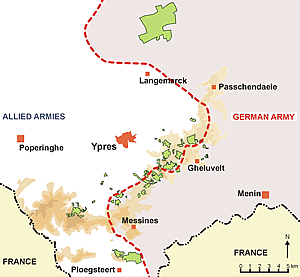
Note on the map the town of Passchendaele on the other side of the German lines. Today we will visit the Ypres sites and tomorrow Passchendaele.
As we approach today’s battlefield sites tour historian Phil Craig gives us the necessary background to appreciate what we are about to see. First off, we have to remember we are in Belgium now and not France. Belgium was a neutral country, not aligned with either German or French interests and according to the usual rules of war was therefore ‘off-limits’. Unfortunately, that didn’t help the Belgians as the Germans, not wanting to make an all out frontal assault against the French fortifications along that border, decided to basically say “F*** Belgium” and sent troops into the country in order to outflank the French. The first German troops showed up in Ypres in October, 1914, but were driven out in the First Battle of Ypres and for the rest of the war the little city remained at the centre of the fighting, ending up totally destroyed.
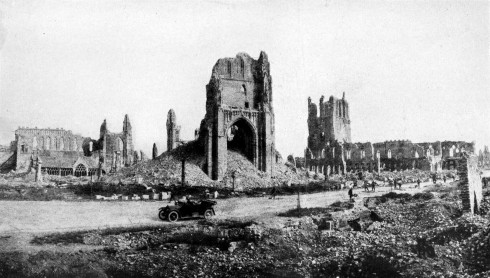
Second Battle of Ypres
The Second Battle of Ypres raged over four days in April 1915 as the Germans tried to retake Ypres and push the Allies back into France. It was a hellish affair as were all these WWI battles as illustrated by this famous painting of the battle by Richard Jack.
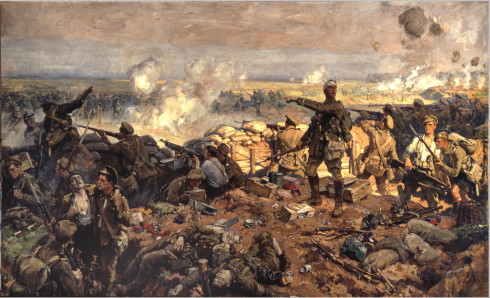
However, the Second Battle of Ypres was also known for something even worse – it was the first time the Germans used poison gas. As noted in an earlier post, both sides had used non-lethal gas before, but this was a new low. Getting off the bus at St. Julian we see another one of the most iconic Canadian War Memorials, The Brooding Soldier by Chapman Clemensha. While it is nowhere near as large as the Vimy Monument, it is still very impressive and looking at it one immediately knows why it is called The Brooding Soldier, and he had a lot to brood about in Ypres.

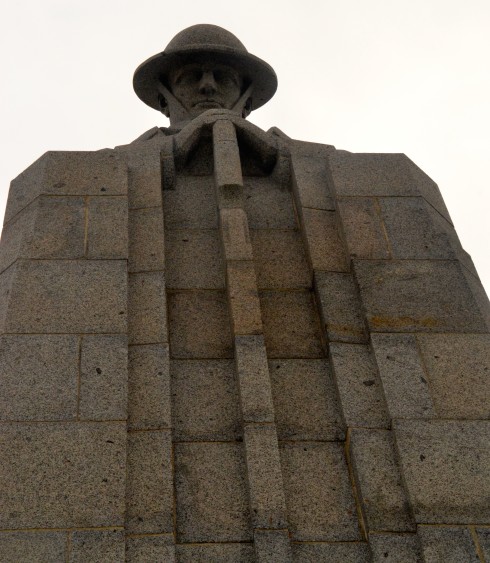
The plaque on the monument reads “This column marks the battlefield where 18,000 Canadians on the British left withstood the first German gas attacks (from) the 22-25 April 1915. 2,000 fell and lie buried nearby.”
The first units to be affected by the gas were Algerians in the 45th French Division who had no idea what the slowly drifting green cloud that was advancing upon them, meant; that is until they breathed it in and began choking and dying. Not surprisingly they fled, leaving the Canadian left flank completely exposed. As the French troops retreated in panic Canadian commanders gradually realized what was happening and ordered their men to urinate in their handkerchiefs and put it over their noses, which no doubt saved the lives of thousands as the gas passed by and the Canadians did not flee.
They were gassed again a few days later, but managed to hold the line until British reinforcements arrived. Canadians had shown not only would they stand their ground, but were innovative thinkers in the face of new enemy tactics. Still, as usual, it was at a horrendous cost – 6,000 casualties. As Phil explained, many of those who were gassed at the Second Battle of Ypres and did not die, were confined to a life of living hell. Not only did the after effects of the gas ravage their bodies, but the horrors of that day left many shell shocked, alcoholic wrecks.
I contemplated this as Alison and I walked around the area and was glad to find a ray of comfort in the beautiful rhododendrons and azaleas that were in full bloom. It just seems natural that flowers bring solace to almost any situation.
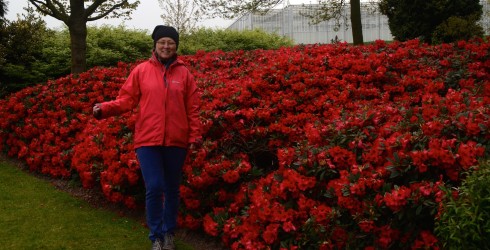
Essex Farm Cemetery
Our next stop in the Ypres area was Essex Farm Cemetery where we just happened to be arriving on a momentous anniversary. It was 100 years ago to the day that Lt. Alexis Hannum Helmer was blown to pieces by a direct hit from a German artillery shell as he reconnoitred Canadian battery positions at the Second Battle of Ypres.
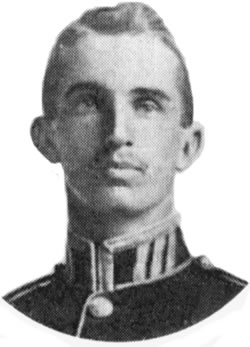
Lt. Helmer was a good friend of then Major John MacRae M.D. who, in this very spot a century ago, said a few words over a simple wooden cross and then sat down, heartbroken, and wrote the most famous war poem ever put to paper, In Flander’s Fields.
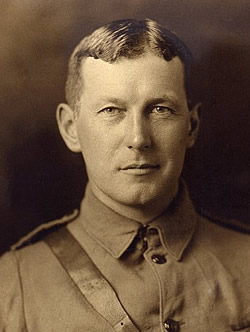
The unbelievable coincidence of being here on the centenary of the events that inspired the poem is humbling. Today there are 1,097 identified remains and 103 unidentified, none of which is Lt. Helmer whose body was so badly destroyed by the direct shell hit that he is now one of the almost 55,000 missing men commemorated on the Menin Gate in Ypres.
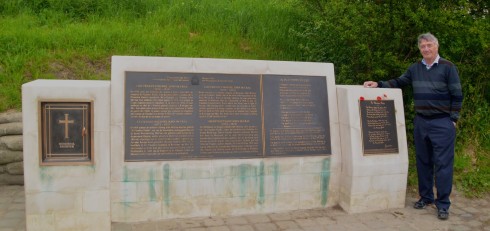
In Flanders fields the poppies blow
Between the crosses, row on row,
That mark our place; and in the sky
The larks, still bravely singing, fly
Scarce heard amid the guns below.
We are the Dead. Short days ago
We lived, felt dawn, saw sunset glow,
Loved and were loved, and now we lie
In Flanders fields.
Take up our quarrel with the foe:
To you from failing hands we throw
The torch; be yours to hold it high.
If ye break faith with us who die
We shall not sleep, though poppies grow
In Flanders fields.
Today there are no crosses and no poppies in this place, at least real ones, but I did hear a skylark singing.
There is one exceptional grave that is worth seeking out here and that is Valentine Joe Strudwick who is the youngest known death in any of the Commonwealth Grave Commission cemeteries. There are no known pictures of Joe, as he was called, who was dead at fifteen, outside Ypres, Belgium a place I’m sure he’d never heard of.
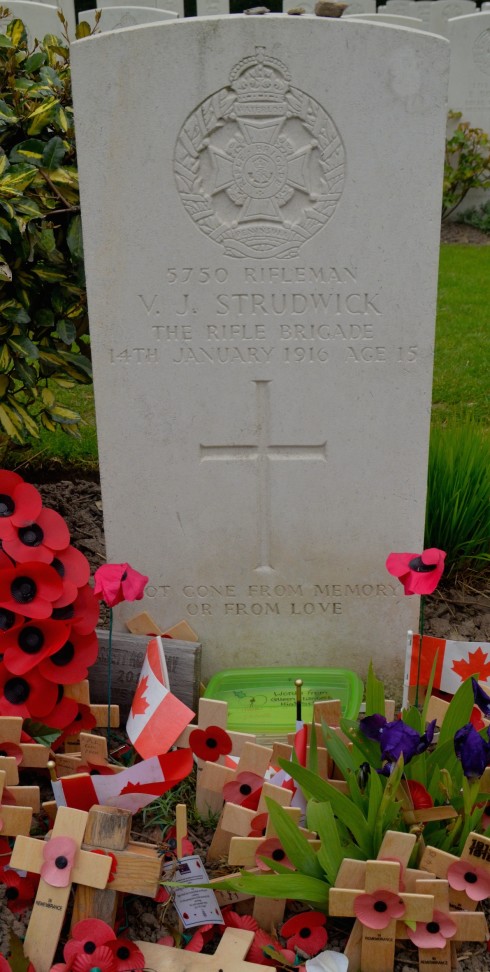
As we were visiting Essex Farm a number of buses pulled up and scads of high school kids emerged looking incredibly young to me, but I realized that most were probably older than Joe Strudwick when he died.
The Second Battle of Ypres did not finish harvesting Canadians at Ypres. For almost two weeks in June, 1916 Canadians bore the brunt of a massive German artillery barrage that killed thousands including the division commander, Major-General Malcolm Mercer. He was the highest ranking Canadian officer killed in the war and it appears that, while he was put in peril initially by the barrage, which left him deaf and wounded, he might actually have been killed by British artillery as he tried to get back to safety. Is there a more odious oxymoron than ‘friendly fire’?
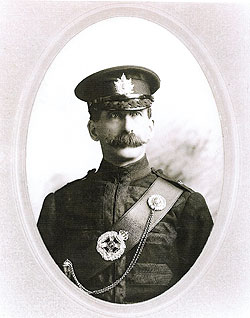
The battle at Mount Sorrel saw the Canadians cede the high ground only to retake it in a set piece attack that was a forerunner of the type of advance planning the Canadians would use at Vimy Ridge. It cost us over 8,000 casualties.
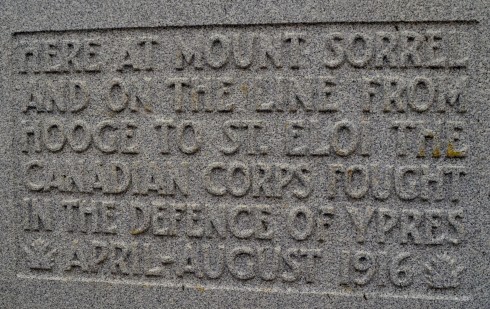
Standing atop the hill today there is a beautiful view of Ypres, literally looking over Flander’s fields.
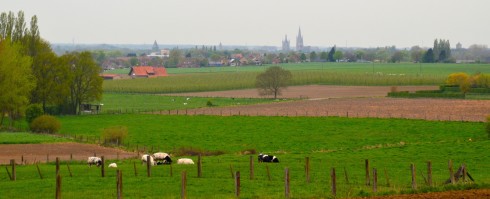
Time to visit this little place that cost so many lives, but not before another iconic Canadian battlefield – Passchendaele. See you there.

